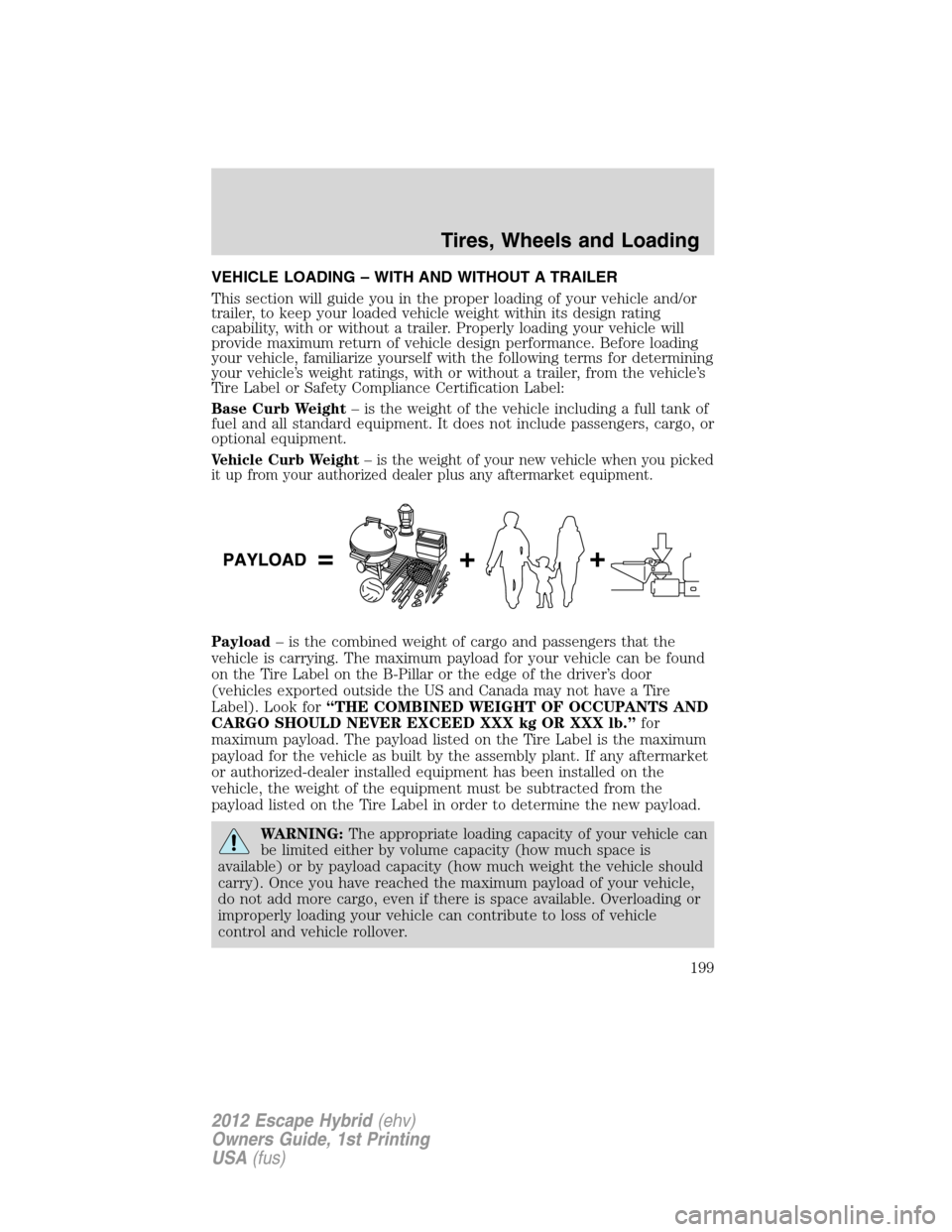Page 199 of 358

VEHICLE LOADING – WITH AND WITHOUT A TRAILER
This section will guide you in the proper loading of your vehicle and/or
trailer, to keep your loaded vehicle weight within its design rating
capability, with or without a trailer. Properly loading your vehicle will
provide maximum return of vehicle design performance. Before loading
your vehicle, familiarize yourself with the following terms for determining
your vehicle’s weight ratings, with or without a trailer, from the vehicle’s
Tire Label or Safety Compliance Certification Label:
Base Curb Weight– is the weight of the vehicle including a full tank of
fuel and all standard equipment. It does not include passengers, cargo, or
optional equipment.
Vehicle Curb Weight– is the weight of your new vehicle when you picked
it up from your authorized dealer plus any aftermarket equipment.
Payload– is the combined weight of cargo and passengers that the
vehicle is carrying. The maximum payload for your vehicle can be found
on the Tire Label on the B-Pillar or the edge of the driver’s door
(vehicles exported outside the US and Canada may not have a Tire
Label). Look for“THE COMBINED WEIGHT OF OCCUPANTS AND
CARGO SHOULD NEVER EXCEED XXX kg OR XXX lb.”for
maximum payload. The payload listed on the Tire Label is the maximum
payload for the vehicle as built by the assembly plant. If any aftermarket
or authorized-dealer installed equipment has been installed on the
vehicle, the weight of the equipment must be subtracted from the
payload listed on the Tire Label in order to determine the new payload.
WARNING:The appropriate loading capacity of your vehicle can
be limited either by volume capacity (how much space is
available) or by payload capacity (how much weight the vehicle should
carry). Once you have reached the maximum payload of your vehicle,
do not add more cargo, even if there is space available. Overloading or
improperly loading your vehicle can contribute to loss of vehicle
control and vehicle rollover.
Tires, Wheels and Loading
199
2012 Escape Hybrid(ehv)
Owners Guide, 1st Printing
USA(fus)
Page 314 of 358

Filling the tank
When the fuel gauge indicates empty, there is still a small reserve of fuel
in the fuel system. When refueling your vehicle after the fuel gauge
indicates empty, you might not be able to refuel the full amount of the
advertised capacity of the fuel tank due to the empty reserve still
present in the tank. The amount of usable fuel in the empty reserve
varies and should not be relied upon to increase driving range.
For consistent results when filling the fuel tank:
•Turn the engine/ignition switch to the off position prior to refueling;
an error in the reading will result if the engine is left running.
•Allow no more than two automatic click-offs when filling.
•Always use fuel with the recommended octane rating.
•Use a known quality gasoline, preferably a national brand.
Your results will be most accurate if your filling method is consistent.
Calculating fuel economy
1. Fill the fuel tank completely and record the initial odometer reading
(in miles or kilometers).
2. Each time you fill the tank, record the amount of fuel added (in
gallons or liters).
3. After at least three to five tank fill-ups, fill the fuel tank and record
the current odometer reading.
4. Subtract your initial odometer reading from the current odometer
reading.
5. Follow one of the simple calculations in order to determine fuel
economy:
Calculation 1:Divide total miles traveled by total gallons used.
Calculation 2:Multiply liters used by 100, then divide by total
kilometers traveled.
Keep a record for at least one month and record the type of driving (city
or highway). This will provide an accurate estimate of the vehicle’s fuel
economy under current driving conditions. Additionally, keeping records
during summer and winter will show how temperature impacts fuel
economy. In general, very hot or very cold temperatures give lower fuel
economy.
Maintenance and Specifications
314
2012 Escape Hybrid(ehv)
Owners Guide, 1st Printing
USA(fus)
Page 326 of 358

Item CapacityFord Part Name or
equivalentFord Part Number / Ford
Specification
Windshield washer
fluidFill as requiredMotorcraft�Premium
Windshield Washer
Concentrate (US)
Premium Quality
Windshield Washer
Fluid (Canada)ZC-32-A (US)
CXC-37-(A, B, D, and F)
(Canada) /
WSB-M8B16-A2/- -
Fuel tank15 gallons
(56.8L)——
1Add the coolant type originally equipped in your vehicle.2Use of synthetic or synthetic blend motor oil is not mandatory. Engine oil need only meet the
requirements of Ford specification WSS-M2C945-A and the API Certification mark.3Indicates only approximate dry-fill capacity.4Using any transmission fluid other than those that meet the recommended specification may cause
internal transmission damage. Do not use Motorcraft�Continuously Variable Chain Type
Transmission Fluid (blue). This vehicle uses only Motorcraft�MERCON�LV AT F.5Fill to 1/4 inch to 9/16 inch (6 mm to 14 mm) below bottom of fill hole.64WD vehicles exposed for prolonged periods to temperatures less than -40°C (-40°F) should
change out the rear axle fluid to Motorcraft�SAE 75W-140 Rear Axle Lubricant, Ford part number
XY-75W140-QL meeting Ford specification WSL-M2C192-A.7The power transfer unit is lubricated for life with synthetic lube. Lubricant levels are not to be
checked or changed unless a leak is suspected or repair required. Replace power transfer unit
lubricant with specified synthetic lubricant anytime the unit is submerged in water.
Maintenance and Specifications
326
2012 Escape Hybrid(ehv)
Owners Guide, 1st Printing
USA(fus)